Security Challenges in Emerging Networks in the Healthcare Sector
VerifiedAdded on 2023/06/07
|8
|2390
|482
Report
AI Summary
This report provides an overview of security challenges within emerging networks, particularly in the healthcare sector. It explores the architecture of healthcare networks, recent developments, and the importance of security. The report identifies three potential security issues: Distributed Denial of Service (DDoS) attacks, man-in-the-middle attacks, and network manipulation. Furthermore, it details relevant mitigation techniques for DDoS attacks, emphasizing the importance of security measures like encryption and verification of SSL setups to protect sensitive data. The report concludes by highlighting the vulnerability of healthcare networks to various security threats and the need for robust protective measures.

Running head: SECURITY CHALLENGES IN EMERGING NETWORKS
Security Challenges in Emerging Networks
Name of the Student
Name of the University
Author’s Note:
Security Challenges in Emerging Networks
Name of the Student
Name of the University
Author’s Note:
Paraphrase This Document
Need a fresh take? Get an instant paraphrase of this document with our AI Paraphraser
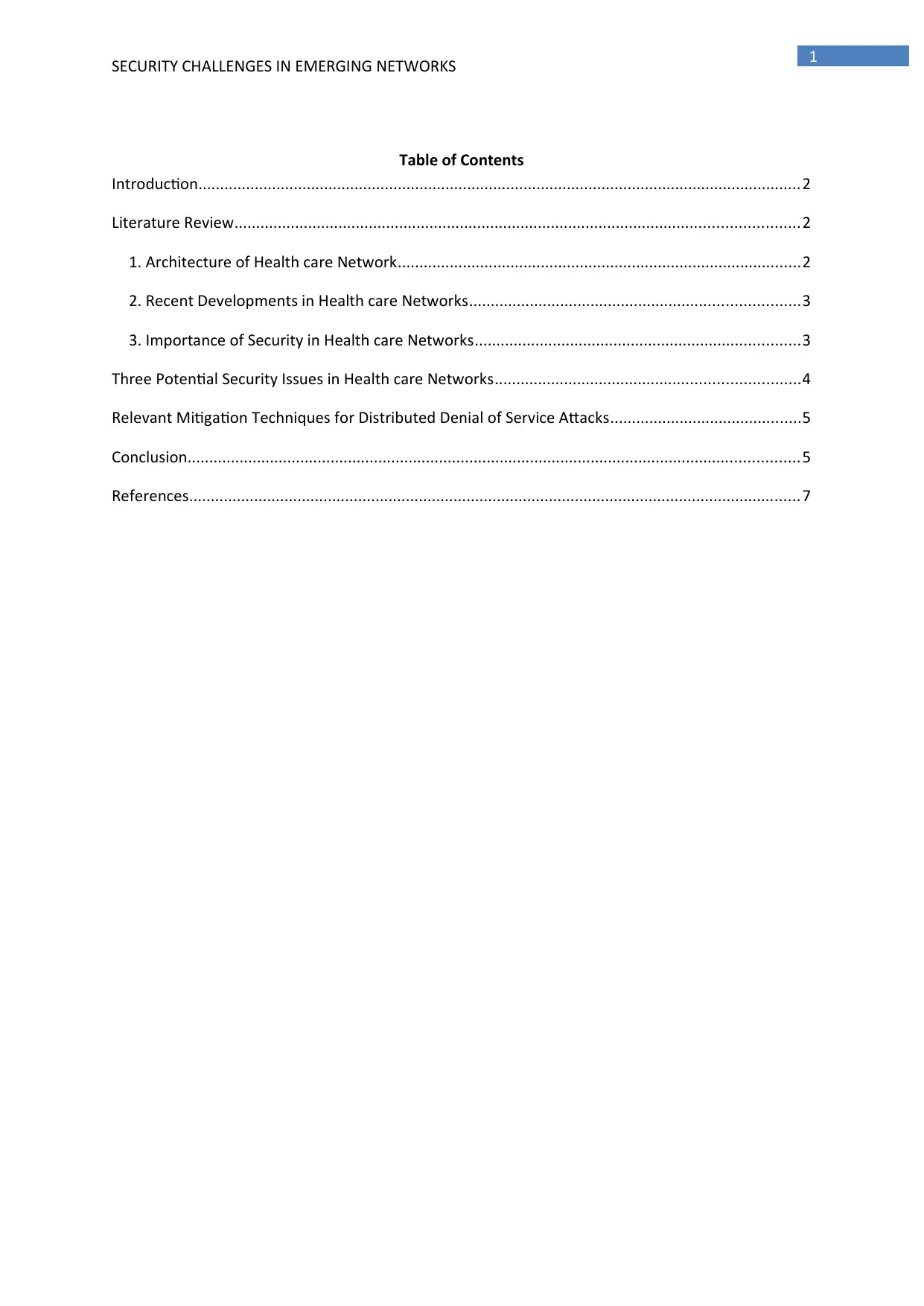
1
SECURITY CHALLENGES IN EMERGING NETWORKS
Table of Contents
Introduction...........................................................................................................................................2
Literature Review..................................................................................................................................2
1. Architecture of Health care Network.............................................................................................2
2. Recent Developments in Health care Networks............................................................................3
3. Importance of Security in Health care Networks...........................................................................3
Three Potential Security Issues in Health care Networks......................................................................4
Relevant Mitigation Techniques for Distributed Denial of Service Attacks............................................5
Conclusion.............................................................................................................................................5
References.............................................................................................................................................7
SECURITY CHALLENGES IN EMERGING NETWORKS
Table of Contents
Introduction...........................................................................................................................................2
Literature Review..................................................................................................................................2
1. Architecture of Health care Network.............................................................................................2
2. Recent Developments in Health care Networks............................................................................3
3. Importance of Security in Health care Networks...........................................................................3
Three Potential Security Issues in Health care Networks......................................................................4
Relevant Mitigation Techniques for Distributed Denial of Service Attacks............................................5
Conclusion.............................................................................................................................................5
References.............................................................................................................................................7
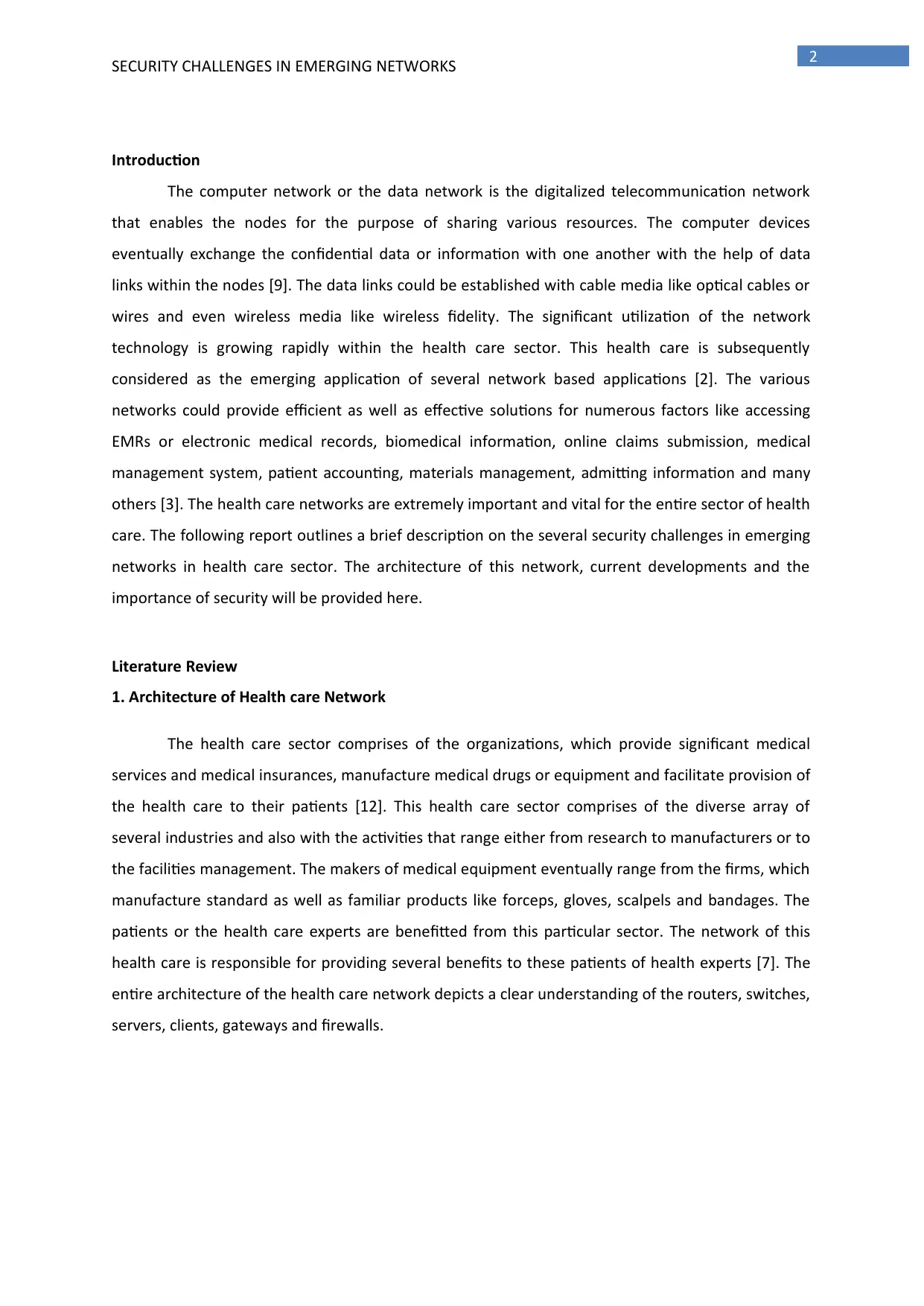
2
SECURITY CHALLENGES IN EMERGING NETWORKS
Introduction
The computer network or the data network is the digitalized telecommunication network
that enables the nodes for the purpose of sharing various resources. The computer devices
eventually exchange the confidential data or information with one another with the help of data
links within the nodes [9]. The data links could be established with cable media like optical cables or
wires and even wireless media like wireless fidelity. The significant utilization of the network
technology is growing rapidly within the health care sector. This health care is subsequently
considered as the emerging application of several network based applications [2]. The various
networks could provide efficient as well as effective solutions for numerous factors like accessing
EMRs or electronic medical records, biomedical information, online claims submission, medical
management system, patient accounting, materials management, admitting information and many
others [3]. The health care networks are extremely important and vital for the entire sector of health
care. The following report outlines a brief description on the several security challenges in emerging
networks in health care sector. The architecture of this network, current developments and the
importance of security will be provided here.
Literature Review
1. Architecture of Health care Network
The health care sector comprises of the organizations, which provide significant medical
services and medical insurances, manufacture medical drugs or equipment and facilitate provision of
the health care to their patients [12]. This health care sector comprises of the diverse array of
several industries and also with the activities that range either from research to manufacturers or to
the facilities management. The makers of medical equipment eventually range from the firms, which
manufacture standard as well as familiar products like forceps, gloves, scalpels and bandages. The
patients or the health care experts are benefitted from this particular sector. The network of this
health care is responsible for providing several benefits to these patients of health experts [7]. The
entire architecture of the health care network depicts a clear understanding of the routers, switches,
servers, clients, gateways and firewalls.
SECURITY CHALLENGES IN EMERGING NETWORKS
Introduction
The computer network or the data network is the digitalized telecommunication network
that enables the nodes for the purpose of sharing various resources. The computer devices
eventually exchange the confidential data or information with one another with the help of data
links within the nodes [9]. The data links could be established with cable media like optical cables or
wires and even wireless media like wireless fidelity. The significant utilization of the network
technology is growing rapidly within the health care sector. This health care is subsequently
considered as the emerging application of several network based applications [2]. The various
networks could provide efficient as well as effective solutions for numerous factors like accessing
EMRs or electronic medical records, biomedical information, online claims submission, medical
management system, patient accounting, materials management, admitting information and many
others [3]. The health care networks are extremely important and vital for the entire sector of health
care. The following report outlines a brief description on the several security challenges in emerging
networks in health care sector. The architecture of this network, current developments and the
importance of security will be provided here.
Literature Review
1. Architecture of Health care Network
The health care sector comprises of the organizations, which provide significant medical
services and medical insurances, manufacture medical drugs or equipment and facilitate provision of
the health care to their patients [12]. This health care sector comprises of the diverse array of
several industries and also with the activities that range either from research to manufacturers or to
the facilities management. The makers of medical equipment eventually range from the firms, which
manufacture standard as well as familiar products like forceps, gloves, scalpels and bandages. The
patients or the health care experts are benefitted from this particular sector. The network of this
health care is responsible for providing several benefits to these patients of health experts [7]. The
entire architecture of the health care network depicts a clear understanding of the routers, switches,
servers, clients, gateways and firewalls.
⊘ This is a preview!⊘
Do you want full access?
Subscribe today to unlock all pages.

Trusted by 1+ million students worldwide
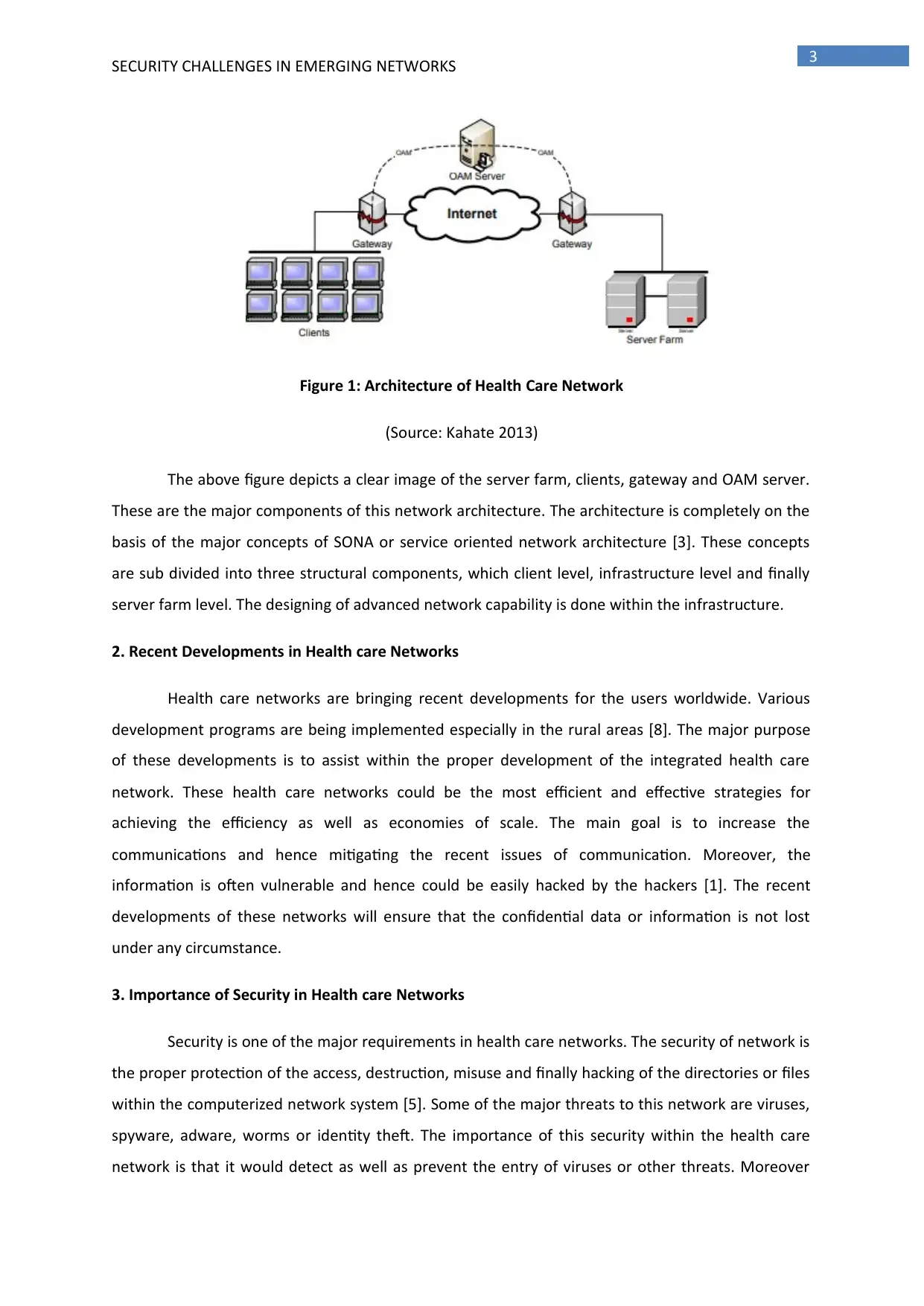
3
SECURITY CHALLENGES IN EMERGING NETWORKS
Figure 1: Architecture of Health Care Network
(Source: Kahate 2013)
The above figure depicts a clear image of the server farm, clients, gateway and OAM server.
These are the major components of this network architecture. The architecture is completely on the
basis of the major concepts of SONA or service oriented network architecture [3]. These concepts
are sub divided into three structural components, which client level, infrastructure level and finally
server farm level. The designing of advanced network capability is done within the infrastructure.
2. Recent Developments in Health care Networks
Health care networks are bringing recent developments for the users worldwide. Various
development programs are being implemented especially in the rural areas [8]. The major purpose
of these developments is to assist within the proper development of the integrated health care
network. These health care networks could be the most efficient and effective strategies for
achieving the efficiency as well as economies of scale. The main goal is to increase the
communications and hence mitigating the recent issues of communication. Moreover, the
information is often vulnerable and hence could be easily hacked by the hackers [1]. The recent
developments of these networks will ensure that the confidential data or information is not lost
under any circumstance.
3. Importance of Security in Health care Networks
Security is one of the major requirements in health care networks. The security of network is
the proper protection of the access, destruction, misuse and finally hacking of the directories or files
within the computerized network system [5]. Some of the major threats to this network are viruses,
spyware, adware, worms or identity theft. The importance of this security within the health care
network is that it would detect as well as prevent the entry of viruses or other threats. Moreover
SECURITY CHALLENGES IN EMERGING NETWORKS
Figure 1: Architecture of Health Care Network
(Source: Kahate 2013)
The above figure depicts a clear image of the server farm, clients, gateway and OAM server.
These are the major components of this network architecture. The architecture is completely on the
basis of the major concepts of SONA or service oriented network architecture [3]. These concepts
are sub divided into three structural components, which client level, infrastructure level and finally
server farm level. The designing of advanced network capability is done within the infrastructure.
2. Recent Developments in Health care Networks
Health care networks are bringing recent developments for the users worldwide. Various
development programs are being implemented especially in the rural areas [8]. The major purpose
of these developments is to assist within the proper development of the integrated health care
network. These health care networks could be the most efficient and effective strategies for
achieving the efficiency as well as economies of scale. The main goal is to increase the
communications and hence mitigating the recent issues of communication. Moreover, the
information is often vulnerable and hence could be easily hacked by the hackers [1]. The recent
developments of these networks will ensure that the confidential data or information is not lost
under any circumstance.
3. Importance of Security in Health care Networks
Security is one of the major requirements in health care networks. The security of network is
the proper protection of the access, destruction, misuse and finally hacking of the directories or files
within the computerized network system [5]. Some of the major threats to this network are viruses,
spyware, adware, worms or identity theft. The importance of this security within the health care
network is that it would detect as well as prevent the entry of viruses or other threats. Moreover
Paraphrase This Document
Need a fresh take? Get an instant paraphrase of this document with our AI Paraphraser
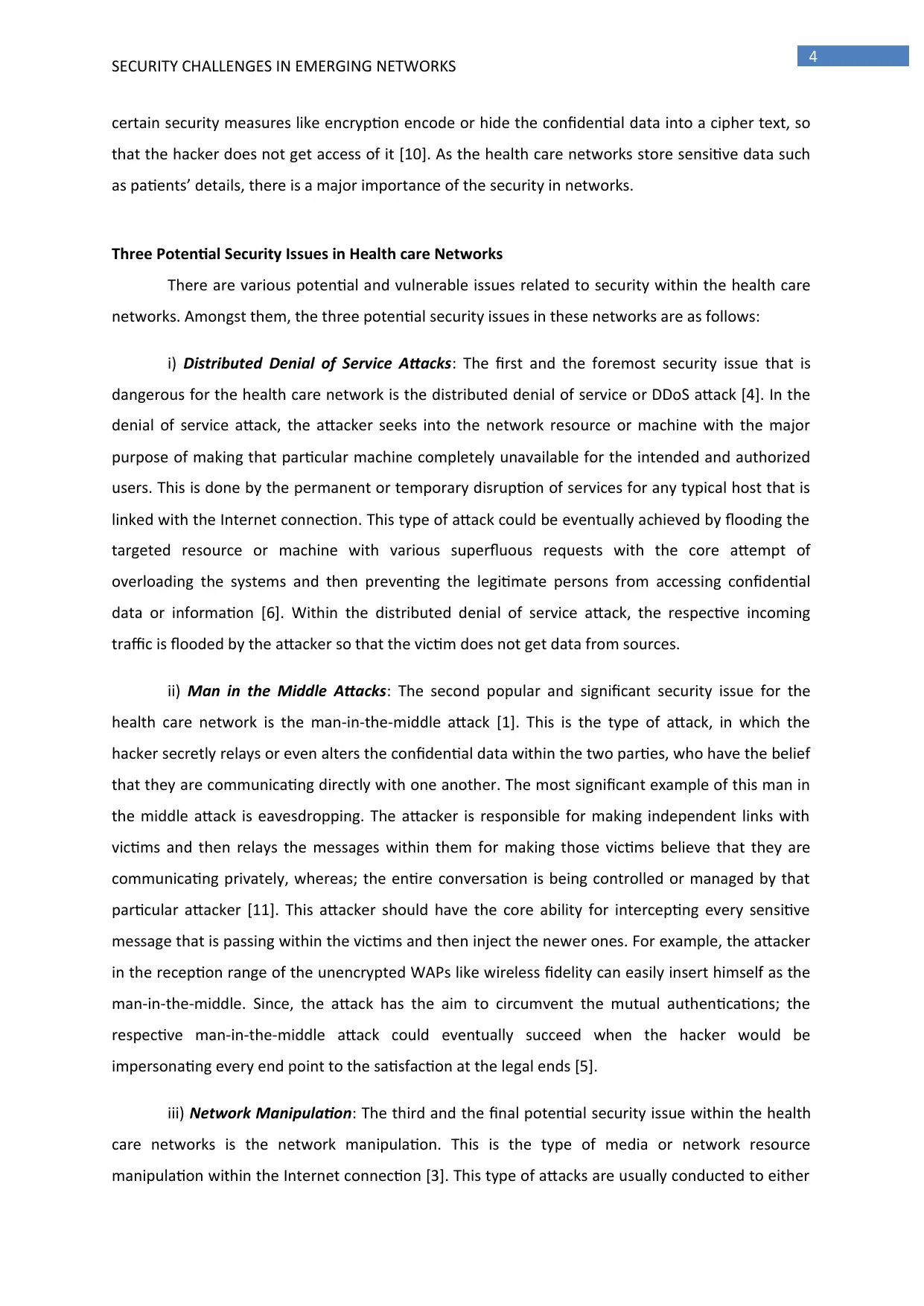
4
SECURITY CHALLENGES IN EMERGING NETWORKS
certain security measures like encryption encode or hide the confidential data into a cipher text, so
that the hacker does not get access of it [10]. As the health care networks store sensitive data such
as patients’ details, there is a major importance of the security in networks.
Three Potential Security Issues in Health care Networks
There are various potential and vulnerable issues related to security within the health care
networks. Amongst them, the three potential security issues in these networks are as follows:
i) Distributed Denial of Service Attacks: The first and the foremost security issue that is
dangerous for the health care network is the distributed denial of service or DDoS attack [4]. In the
denial of service attack, the attacker seeks into the network resource or machine with the major
purpose of making that particular machine completely unavailable for the intended and authorized
users. This is done by the permanent or temporary disruption of services for any typical host that is
linked with the Internet connection. This type of attack could be eventually achieved by flooding the
targeted resource or machine with various superfluous requests with the core attempt of
overloading the systems and then preventing the legitimate persons from accessing confidential
data or information [6]. Within the distributed denial of service attack, the respective incoming
traffic is flooded by the attacker so that the victim does not get data from sources.
ii) Man in the Middle Attacks: The second popular and significant security issue for the
health care network is the man-in-the-middle attack [1]. This is the type of attack, in which the
hacker secretly relays or even alters the confidential data within the two parties, who have the belief
that they are communicating directly with one another. The most significant example of this man in
the middle attack is eavesdropping. The attacker is responsible for making independent links with
victims and then relays the messages within them for making those victims believe that they are
communicating privately, whereas; the entire conversation is being controlled or managed by that
particular attacker [11]. This attacker should have the core ability for intercepting every sensitive
message that is passing within the victims and then inject the newer ones. For example, the attacker
in the reception range of the unencrypted WAPs like wireless fidelity can easily insert himself as the
man-in-the-middle. Since, the attack has the aim to circumvent the mutual authentications; the
respective man-in-the-middle attack could eventually succeed when the hacker would be
impersonating every end point to the satisfaction at the legal ends [5].
iii) Network Manipulation: The third and the final potential security issue within the health
care networks is the network manipulation. This is the type of media or network resource
manipulation within the Internet connection [3]. This type of attacks are usually conducted to either
SECURITY CHALLENGES IN EMERGING NETWORKS
certain security measures like encryption encode or hide the confidential data into a cipher text, so
that the hacker does not get access of it [10]. As the health care networks store sensitive data such
as patients’ details, there is a major importance of the security in networks.
Three Potential Security Issues in Health care Networks
There are various potential and vulnerable issues related to security within the health care
networks. Amongst them, the three potential security issues in these networks are as follows:
i) Distributed Denial of Service Attacks: The first and the foremost security issue that is
dangerous for the health care network is the distributed denial of service or DDoS attack [4]. In the
denial of service attack, the attacker seeks into the network resource or machine with the major
purpose of making that particular machine completely unavailable for the intended and authorized
users. This is done by the permanent or temporary disruption of services for any typical host that is
linked with the Internet connection. This type of attack could be eventually achieved by flooding the
targeted resource or machine with various superfluous requests with the core attempt of
overloading the systems and then preventing the legitimate persons from accessing confidential
data or information [6]. Within the distributed denial of service attack, the respective incoming
traffic is flooded by the attacker so that the victim does not get data from sources.
ii) Man in the Middle Attacks: The second popular and significant security issue for the
health care network is the man-in-the-middle attack [1]. This is the type of attack, in which the
hacker secretly relays or even alters the confidential data within the two parties, who have the belief
that they are communicating directly with one another. The most significant example of this man in
the middle attack is eavesdropping. The attacker is responsible for making independent links with
victims and then relays the messages within them for making those victims believe that they are
communicating privately, whereas; the entire conversation is being controlled or managed by that
particular attacker [11]. This attacker should have the core ability for intercepting every sensitive
message that is passing within the victims and then inject the newer ones. For example, the attacker
in the reception range of the unencrypted WAPs like wireless fidelity can easily insert himself as the
man-in-the-middle. Since, the attack has the aim to circumvent the mutual authentications; the
respective man-in-the-middle attack could eventually succeed when the hacker would be
impersonating every end point to the satisfaction at the legal ends [5].
iii) Network Manipulation: The third and the final potential security issue within the health
care networks is the network manipulation. This is the type of media or network resource
manipulation within the Internet connection [3]. This type of attacks are usually conducted to either
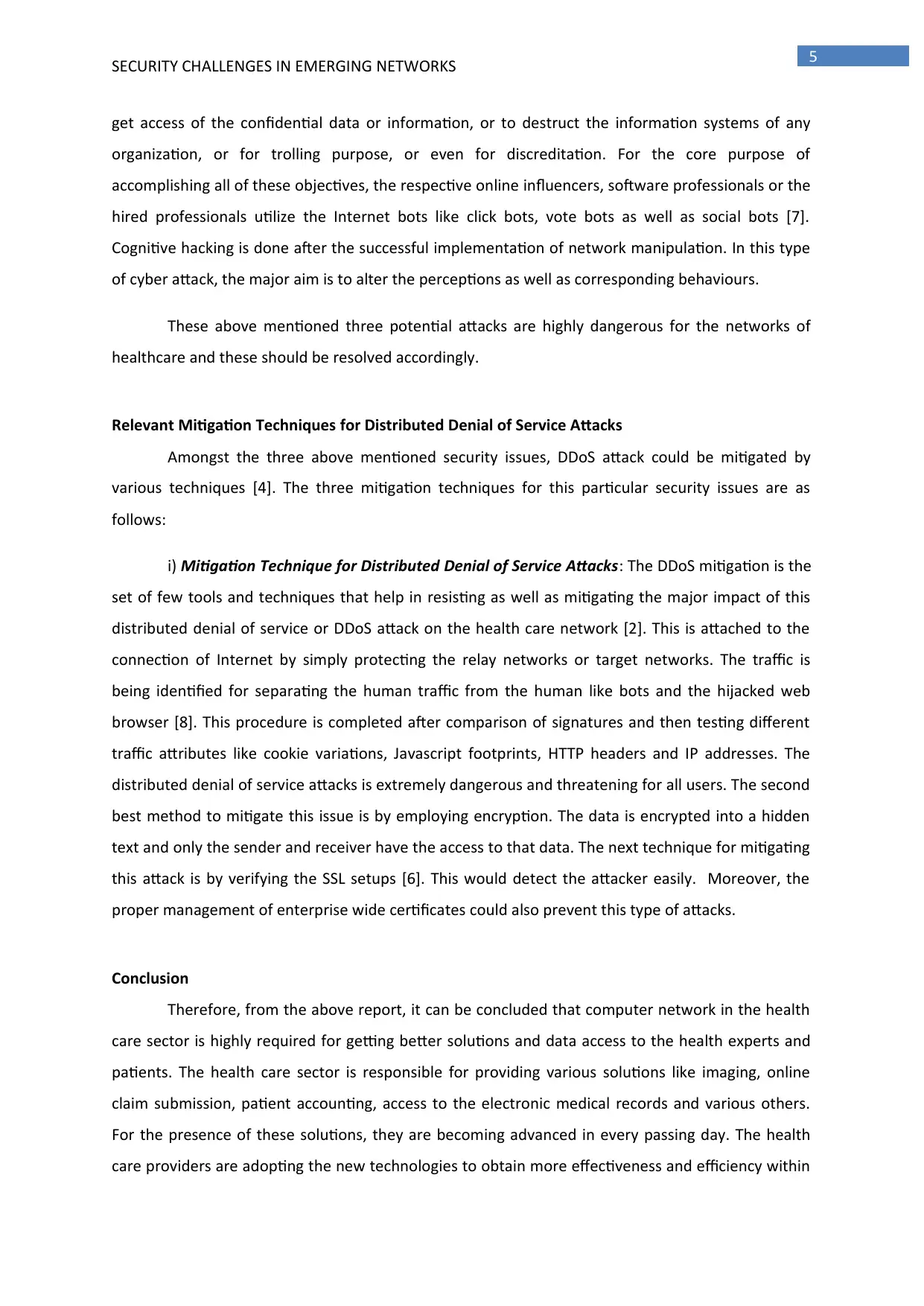
5
SECURITY CHALLENGES IN EMERGING NETWORKS
get access of the confidential data or information, or to destruct the information systems of any
organization, or for trolling purpose, or even for discreditation. For the core purpose of
accomplishing all of these objectives, the respective online influencers, software professionals or the
hired professionals utilize the Internet bots like click bots, vote bots as well as social bots [7].
Cognitive hacking is done after the successful implementation of network manipulation. In this type
of cyber attack, the major aim is to alter the perceptions as well as corresponding behaviours.
These above mentioned three potential attacks are highly dangerous for the networks of
healthcare and these should be resolved accordingly.
Relevant Mitigation Techniques for Distributed Denial of Service Attacks
Amongst the three above mentioned security issues, DDoS attack could be mitigated by
various techniques [4]. The three mitigation techniques for this particular security issues are as
follows:
i) Mitigation Technique for Distributed Denial of Service Attacks: The DDoS mitigation is the
set of few tools and techniques that help in resisting as well as mitigating the major impact of this
distributed denial of service or DDoS attack on the health care network [2]. This is attached to the
connection of Internet by simply protecting the relay networks or target networks. The traffic is
being identified for separating the human traffic from the human like bots and the hijacked web
browser [8]. This procedure is completed after comparison of signatures and then testing different
traffic attributes like cookie variations, Javascript footprints, HTTP headers and IP addresses. The
distributed denial of service attacks is extremely dangerous and threatening for all users. The second
best method to mitigate this issue is by employing encryption. The data is encrypted into a hidden
text and only the sender and receiver have the access to that data. The next technique for mitigating
this attack is by verifying the SSL setups [6]. This would detect the attacker easily. Moreover, the
proper management of enterprise wide certificates could also prevent this type of attacks.
Conclusion
Therefore, from the above report, it can be concluded that computer network in the health
care sector is highly required for getting better solutions and data access to the health experts and
patients. The health care sector is responsible for providing various solutions like imaging, online
claim submission, patient accounting, access to the electronic medical records and various others.
For the presence of these solutions, they are becoming advanced in every passing day. The health
care providers are adopting the new technologies to obtain more effectiveness and efficiency within
SECURITY CHALLENGES IN EMERGING NETWORKS
get access of the confidential data or information, or to destruct the information systems of any
organization, or for trolling purpose, or even for discreditation. For the core purpose of
accomplishing all of these objectives, the respective online influencers, software professionals or the
hired professionals utilize the Internet bots like click bots, vote bots as well as social bots [7].
Cognitive hacking is done after the successful implementation of network manipulation. In this type
of cyber attack, the major aim is to alter the perceptions as well as corresponding behaviours.
These above mentioned three potential attacks are highly dangerous for the networks of
healthcare and these should be resolved accordingly.
Relevant Mitigation Techniques for Distributed Denial of Service Attacks
Amongst the three above mentioned security issues, DDoS attack could be mitigated by
various techniques [4]. The three mitigation techniques for this particular security issues are as
follows:
i) Mitigation Technique for Distributed Denial of Service Attacks: The DDoS mitigation is the
set of few tools and techniques that help in resisting as well as mitigating the major impact of this
distributed denial of service or DDoS attack on the health care network [2]. This is attached to the
connection of Internet by simply protecting the relay networks or target networks. The traffic is
being identified for separating the human traffic from the human like bots and the hijacked web
browser [8]. This procedure is completed after comparison of signatures and then testing different
traffic attributes like cookie variations, Javascript footprints, HTTP headers and IP addresses. The
distributed denial of service attacks is extremely dangerous and threatening for all users. The second
best method to mitigate this issue is by employing encryption. The data is encrypted into a hidden
text and only the sender and receiver have the access to that data. The next technique for mitigating
this attack is by verifying the SSL setups [6]. This would detect the attacker easily. Moreover, the
proper management of enterprise wide certificates could also prevent this type of attacks.
Conclusion
Therefore, from the above report, it can be concluded that computer network in the health
care sector is highly required for getting better solutions and data access to the health experts and
patients. The health care sector is responsible for providing various solutions like imaging, online
claim submission, patient accounting, access to the electronic medical records and various others.
For the presence of these solutions, they are becoming advanced in every passing day. The health
care providers are adopting the new technologies to obtain more effectiveness and efficiency within
⊘ This is a preview!⊘
Do you want full access?
Subscribe today to unlock all pages.

Trusted by 1+ million students worldwide

6
SECURITY CHALLENGES IN EMERGING NETWORKS
the sector. However, in spite of having these advantages and solutions, these networks are
vulnerable to various types of security issues or challenges. The hackers or attackers could easily
hack the data. The above report has properly explained the concept of health care networks. The
architecture of this network and the recent development of health care networks are provided here.
Moreover, the three potential security issues for health care networks with the mitigation
techniques for one of them are also given in this report.
SECURITY CHALLENGES IN EMERGING NETWORKS
the sector. However, in spite of having these advantages and solutions, these networks are
vulnerable to various types of security issues or challenges. The hackers or attackers could easily
hack the data. The above report has properly explained the concept of health care networks. The
architecture of this network and the recent development of health care networks are provided here.
Moreover, the three potential security issues for health care networks with the mitigation
techniques for one of them are also given in this report.
Paraphrase This Document
Need a fresh take? Get an instant paraphrase of this document with our AI Paraphraser
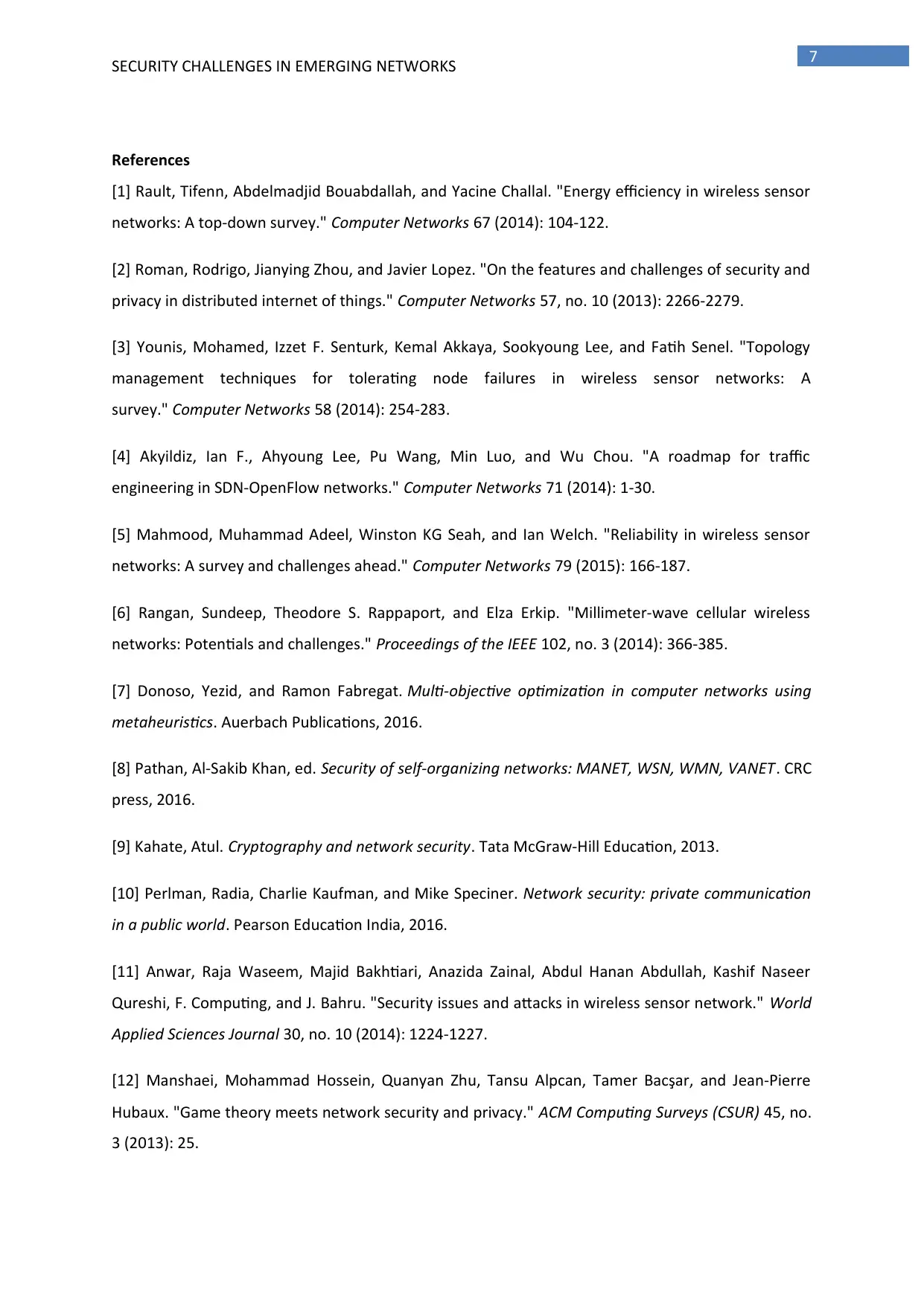
7
SECURITY CHALLENGES IN EMERGING NETWORKS
References
[1] Rault, Tifenn, Abdelmadjid Bouabdallah, and Yacine Challal. "Energy efficiency in wireless sensor
networks: A top-down survey." Computer Networks 67 (2014): 104-122.
[2] Roman, Rodrigo, Jianying Zhou, and Javier Lopez. "On the features and challenges of security and
privacy in distributed internet of things." Computer Networks 57, no. 10 (2013): 2266-2279.
[3] Younis, Mohamed, Izzet F. Senturk, Kemal Akkaya, Sookyoung Lee, and Fatih Senel. "Topology
management techniques for tolerating node failures in wireless sensor networks: A
survey." Computer Networks 58 (2014): 254-283.
[4] Akyildiz, Ian F., Ahyoung Lee, Pu Wang, Min Luo, and Wu Chou. "A roadmap for traffic
engineering in SDN-OpenFlow networks." Computer Networks 71 (2014): 1-30.
[5] Mahmood, Muhammad Adeel, Winston KG Seah, and Ian Welch. "Reliability in wireless sensor
networks: A survey and challenges ahead." Computer Networks 79 (2015): 166-187.
[6] Rangan, Sundeep, Theodore S. Rappaport, and Elza Erkip. "Millimeter-wave cellular wireless
networks: Potentials and challenges." Proceedings of the IEEE 102, no. 3 (2014): 366-385.
[7] Donoso, Yezid, and Ramon Fabregat. Multi-objective optimization in computer networks using
metaheuristics. Auerbach Publications, 2016.
[8] Pathan, Al-Sakib Khan, ed. Security of self-organizing networks: MANET, WSN, WMN, VANET. CRC
press, 2016.
[9] Kahate, Atul. Cryptography and network security. Tata McGraw-Hill Education, 2013.
[10] Perlman, Radia, Charlie Kaufman, and Mike Speciner. Network security: private communication
in a public world. Pearson Education India, 2016.
[11] Anwar, Raja Waseem, Majid Bakhtiari, Anazida Zainal, Abdul Hanan Abdullah, Kashif Naseer
Qureshi, F. Computing, and J. Bahru. "Security issues and attacks in wireless sensor network." World
Applied Sciences Journal 30, no. 10 (2014): 1224-1227.
[12] Manshaei, Mohammad Hossein, Quanyan Zhu, Tansu Alpcan, Tamer Bacşar, and Jean-Pierre
Hubaux. "Game theory meets network security and privacy." ACM Computing Surveys (CSUR) 45, no.
3 (2013): 25.
SECURITY CHALLENGES IN EMERGING NETWORKS
References
[1] Rault, Tifenn, Abdelmadjid Bouabdallah, and Yacine Challal. "Energy efficiency in wireless sensor
networks: A top-down survey." Computer Networks 67 (2014): 104-122.
[2] Roman, Rodrigo, Jianying Zhou, and Javier Lopez. "On the features and challenges of security and
privacy in distributed internet of things." Computer Networks 57, no. 10 (2013): 2266-2279.
[3] Younis, Mohamed, Izzet F. Senturk, Kemal Akkaya, Sookyoung Lee, and Fatih Senel. "Topology
management techniques for tolerating node failures in wireless sensor networks: A
survey." Computer Networks 58 (2014): 254-283.
[4] Akyildiz, Ian F., Ahyoung Lee, Pu Wang, Min Luo, and Wu Chou. "A roadmap for traffic
engineering in SDN-OpenFlow networks." Computer Networks 71 (2014): 1-30.
[5] Mahmood, Muhammad Adeel, Winston KG Seah, and Ian Welch. "Reliability in wireless sensor
networks: A survey and challenges ahead." Computer Networks 79 (2015): 166-187.
[6] Rangan, Sundeep, Theodore S. Rappaport, and Elza Erkip. "Millimeter-wave cellular wireless
networks: Potentials and challenges." Proceedings of the IEEE 102, no. 3 (2014): 366-385.
[7] Donoso, Yezid, and Ramon Fabregat. Multi-objective optimization in computer networks using
metaheuristics. Auerbach Publications, 2016.
[8] Pathan, Al-Sakib Khan, ed. Security of self-organizing networks: MANET, WSN, WMN, VANET. CRC
press, 2016.
[9] Kahate, Atul. Cryptography and network security. Tata McGraw-Hill Education, 2013.
[10] Perlman, Radia, Charlie Kaufman, and Mike Speciner. Network security: private communication
in a public world. Pearson Education India, 2016.
[11] Anwar, Raja Waseem, Majid Bakhtiari, Anazida Zainal, Abdul Hanan Abdullah, Kashif Naseer
Qureshi, F. Computing, and J. Bahru. "Security issues and attacks in wireless sensor network." World
Applied Sciences Journal 30, no. 10 (2014): 1224-1227.
[12] Manshaei, Mohammad Hossein, Quanyan Zhu, Tansu Alpcan, Tamer Bacşar, and Jean-Pierre
Hubaux. "Game theory meets network security and privacy." ACM Computing Surveys (CSUR) 45, no.
3 (2013): 25.
1 out of 8
Related Documents
Your All-in-One AI-Powered Toolkit for Academic Success.
+13062052269
info@desklib.com
Available 24*7 on WhatsApp / Email
![[object Object]](/_next/static/media/star-bottom.7253800d.svg)
Unlock your academic potential
Copyright © 2020–2025 A2Z Services. All Rights Reserved. Developed and managed by ZUCOL.



